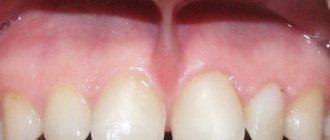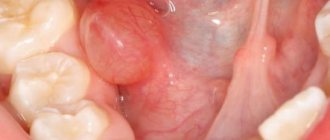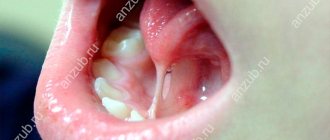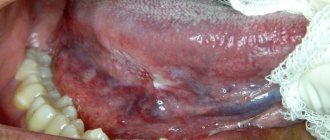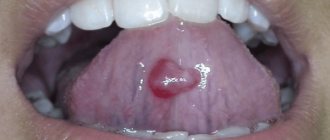The lingual frenulum is a special fold on the oral mucosa that connects the middle of the tongue to the lower part of the gum in the area of the lower anterior incisors. An anomaly occurs - a shortened frenulum or ankyloglossia. The anomaly implies the location of the frenulum as close as possible to the tip of the tongue and limits its motor functions.
Interesting facts: ankyloglossia occurs in almost 5 percent of people, most often observed in men in a ratio of 3 to 1, 1/4 of newborns have difficulty breastfeeding due to a short frenulum.
What is a bridle
The frenulum under the tongue is located on the lower surface of the organ and externally resembles a continuation of its midline . This formation has received a common name because it seems to hold the tongue as it rises upward. The frenulum begins from the middle of the tongue, where there is a border of the transition of the mucous membrane, and then it descends in an arc almost to the base of the gums near the central lower incisors.
This position of the frenulum is normal, so it does not interfere with the movements of the tongue in the oral cavity. On average, in an adult, its length can reach three centimeters.
For the first time, doctors pay attention to the frenulum in the maternity hospital, immediately after the baby is born. Such close attention is due to the fact that very often the bridle has defects and it needs to be trimmed as early as possible . The most common pathology is its shortening and displacement: it is located at the very tip of the tongue, and when the tongue is raised, it takes the form of a groove.
When the tongue sticks out, the frenulum with pathology does not allow the tongue to fully extend, which is why it only slightly covers the edge of the lower lip. Usually such a defect is not accompanied by a true shortening of size, but the abnormal location leads to the same symptoms as with a short frenulum, so it has to be trimmed.
In some children, the frenulum is indeed smaller than necessary, but this feature may not affect the function of the tongue. But not all babies are so lucky - according to the observations of doctors, children with anomalies still have problems sucking the mother's breast, so parents still go to the doctor for trimming, feeling the first problems with latching on the nipple and the baby's movements during feeding.
Signs of a short frenulum can be seen in the following manifestations:
- problems with feeding arise already at the very beginning of the process - the child cannot grasp and hold the nipple for a long time, movements during feeding cause him noticeable difficulties;
- children do not eat enough after feeding;
- the baby does not fall asleep on an empty stomach, he becomes restless and capricious;
- children with an anomaly may lose weight until plastic surgery of the frenulum of the tongue is performed.
In the future, if trimming is not done, a bridle that is too short may interfere with the pronunciation of sounds. usually have difficulty with the sounds -l, -s, –r . The tongue is located approximately in the middle between the teeth, both when talking and with the mouth closed.
Because of this, an incorrect bite is formed, extraneous whistling sounds appear when speaking, and problems with chewing and digesting food are observed: a lump of food that is too coarse is swallowed due to insufficient grinding.
Signs of anomaly
Among the signs of the presence of a short frenulum of the tongue, it is worth noting: during the period of raising the tongue, it takes on a heart-shaped shape; the tongue cannot be pulled out so that the tip takes on a sharp shape; when protruding the tongue, its tip looks down; it is difficult to chew and swallow, and babies have a disturbed sucking reflex; altered diction and difficulties during the conversation; bite changes; periodontal diseases.
It is quite difficult to independently identify the pathology, since in the presence of a slight shortening of the frenulum, all symptoms are washed away. It is for this reason that it is necessary to consult a dentist. Newborns are examined by pediatricians, and children can also be shown to surgeons.
Content:
- Signs of anomaly
- Indications for lingual frenuloplasty
- Contraindications to the procedure
- Tongue frenuloplasty (laser or scalpel)
- Recommendations after surgery
When is the best time to cut a child's frenulum?
Doctors recommend trimming the frenulum of the tongue at an early age , but nothing bad will happen if the operation is performed a little later, in the preschool period. Usually, significant problems in a child are detected already in the first year of life, if the mucous membrane under the tongue is not trimmed. Parents complain to the pediatrician about problems, and after an examination the doctor gives a referral to a dentist, who performs the trimming.
Children under one year old have a rather thin mucous membrane of the frenulum. There are practically no nerve endings in it, and during the neonatal period they are completely absent. Therefore, at such an early age, tongue frenuloplasty is performed without anesthesia, and bleeding is minimal.
If the child was not trimmed in early childhood, the doctor will recommend this in the future. After all, if problems with the frenulum do not manifest themselves during breastfeeding, then the next step is pronunciation of sounds - with a short frenulum, the child experiences typical problems, and the parents turn to a speech therapist.
At an early stage, the doctor will recommend conservative treatment - special exercises for stretching the frenulum, but if there is no positive result, the speech therapist will still give a referral for plastic surgery of the frenulum of the tongue. The trimming is also carried out by a dentist, but using local anesthesia, as well as suturing after surgery.
The optimal time to perform surgery to trim the frenulum of the tongue is up to one year of age. During this period, the intervention occurs most painlessly, the kids will not even remember that they have ever undergone the pruning procedure. The mucous membrane heals quickly, and with early breastfeeding after surgery, the frenulum immediately develops in the process of extracting milk.
Not all doctors support early frenulum trimming . If a child eats well in the first year of life, this does not mean at all that problems with the frenulum may appear in speech therapy at the age of four or five years. Therefore, there is no point in trimming the frenulum for the sake of prevention at an early age, so as not to further injure the baby.
If the speech therapist has determined the indications for pruning, then intervention can be carried out already at this age.
What happens if tongue frenuloplasty is not performed in children?
An abnormality of the frenulum of the tongue in children provokes the following serious consequences.
- Due to a violation of the sucking regime in infancy, the child may not receive enough nutrition and, as a result, lag behind in development.
- Children with tongue frenulum abnormalities may never learn to pronounce some sounds.
- Incorrect placement of the frenulum leads to underdevelopment of the lower jaw, resulting in the formation of an incorrect bite.
If pathology of the frenulum of the tongue has been identified in a newborn, it can be easily corrected by making an incision with a laser. At this age, you won't even need stitches. With age, the structure of the frenulum becomes more complex, new vessels appear in it, so plastic surgery of the frenulum in preschool and school-age children turns into a full-fledged surgical operation. Therefore, it is best to do it at the age of 5-6 years, when the child’s milk teeth are replaced by permanent ones.
Parents can determine whether their child needs surgery on their own. To do this, ask him to reach the upper palate with the tip of his tongue. If he cannot do this, or it hurts, he should consult a doctor.
Preparing for the intervention
Typically, bridle trimming is carried out without any serious preparatory steps. This intervention is low-traumatic and occurs without complications in almost all young patients. In rare cases, when there are somatic pathologies or risks during the procedure, doctors may prescribe the following tests and examinations before the operation:
- general blood analysis;
- blood clotting test;
- fluorographic examination.
It is recommended to feed the child a little before the operation. Firstly, the baby will not experience so much stress, and secondly, after the procedure, children do not dare to eat for some time, so pre-feeding will come in handy.
Methods of performing the operation
There are several ways in which plastic surgery of the frenulum of the tongue is performed - using a scalpel and using a laser. The frenulum was always trimmed with a scalpel; this is a classic way to get rid of the anomaly. Laser is a new product of recent years, which has shown itself to be excellent in carrying out this type of intervention.
The operation using a scalpel takes about twenty minutes on average. During this time, an incision is made on the mucous membrane, the bleeding stops, and stitches are applied if necessary. After such an intervention, children develop swelling in the tongue area and minor discomfort remains for some time.
Typically, the postoperative scar disappears by the end of the first week. During this time, it is recommended to rinse your mouth with special solutions.
With the help of a laser, you can deal with the frenulum much faster - the intervention takes about ten minutes. The cutting process is painless, there is practically no blood, since it is immediately “baked” by the laser. The wound heals immediately, so there is no need to apply stitches.
A spray or gel can be used as anesthesia, and this is done more for the purpose of sedation, since even after the operation the discomfort is insignificant. The scar heals within one to two days.
The differences between the methods are significant, although the result is the same - one way or another, the wound surface heals and the child’s problem with the length of the frenulum is solved. Laser treatment is more expensive, but the procedure is more gentle, so doctors recommend choosing it.
Causes of the defect
A short frenulum of the tongue in a newborn is a congenital anomaly that occurs in the first months of fetal development, when all organs are formed. There are several reasons for its appearance:
- The presence of a hereditary predisposition: if the parents had such a feature, it can be inherited.
- The older the expectant mother, the more likely her child is to develop a short frenulum due to the increased risk of developing anomalies.
- The defect can develop if a woman has an infection during pregnancy or suffers from chronic diseases.
- Severe early toxicosis can lead to a lack of nutrients, which is why the fetal organs do not form correctly.
- Exposure to any teratogenic factors: radiation, toxic substances, drugs that are harmful to the body, alcohol, tobacco and drugs.
- Accidents involving injuries to pregnant women.
Some of these reasons do not depend on the actions of future parents, especially genetic predisposition. Other risk factors should be avoided: a pregnant woman should not work in hazardous work, drink, smoke, self-medicate, or expose herself to the risk of falls when playing sports.
Possible complications
After the procedure, children may experience some complications. Infants especially react to the procedure - they may refuse to eat, become whiny and restless , sleep poorly - this is a normal reaction of the body to the intervention.
Children rarely experience such stress, so parental support is important at this time. Most complications are completely avoidable. Among them, doctors note:
- minor pain after the procedure, which usually goes away after a couple of days;
- an increase in body temperature, which may be an individual reaction of the body to the intervention. If the temperature does not drop, then you need to visit the doctor again - perhaps an infection has occurred and an inflammatory process has begun;
- the appearance of a postoperative scar , which sometimes forces plastic surgery to be repeated.
Complete rehabilitation after surgery takes seven to ten days . During this time, all negative consequences after the operation disappear, children begin to eat normally, pronounce all sounds, and return to the usual rhythm of life.
Recommendations "A set of exercises for stretching the hypoglossal ligament"
Municipal budgetary educational institution secondary school No. 2 in the village of Redkino, Konakovsky district, Tver region
A SET OF EXERCISES FOR STRETCHING THE HYPOGLOUS LIGAMENT
Compiled by: teacher-speech therapist Terentyeva M.V.
A set of exercises for stretching the hypoglossal ligament
Even if the frenulum is shortened (less than 8 mm), it is better to stretch it than to operate. This is supported by the fact that after the operation there will be a scar on the frenulum, which will also reduce its mobility. In addition, the operated child will be afraid to do articulation exercises for the hypoglossal ligament for a long time in order to avoid the previously experienced pain.
The short frenulum of the tongue is stretched to the required length using special exercises. If it is very short, it may take quite some time to stretch it.
Normally, the length of the frenulum is 1.5 cm. If the frenulum is shortened, the movements of the tongue are limited. Consequently, the pronunciation of sounds that require raising the tongue upward is impaired.
Rules for making sounds with a short frenulum
- Sounds that require a noticeable upward movement of the tip of the tongue (r, w, g) are placed after the child’s hyoid ligament is fully stretched.
- Sounds (l, h, sch, th, d) can be started when the frenulum has not yet fully stretched, but there is already some upward movement of the tip of the tongue.
- A short frenulum does not interfere with the normal pronunciation of other sounds of the Russian language.
Rules for performing exercises
- When performing exercises, the mouth should be opened as wide as possible, but at the same time so that the child can reach the alveoli with the tip of the tongue.
- All movements should be performed slowly, with a smile, close to the limit of what is possible.
- It should be borne in mind that performing exercises is physically difficult for a child, the tongue may get tired, the hyoid ligament may hurt - give him rest.
Exercise "Painter"
Smile, open your mouth. Using the wide tip of your tongue, stroke the palate from the teeth to the throat. The lower jaw should not move.
It's time to paint the rooms.
A painter was hired.
We lower the jaw lower,
We help the painter.
Exercise "Horse"
Smile, open your mouth. Click the tip of your tongue like a horse clicking. The mouth is open, the tip of the tongue is not extended or pointed. Make sure that it does not tuck inward and that the lower jaw remains motionless.
We're riding, we're riding a horse along a smooth path. A neighbor invited us to visit for sweet pudding. We arrived at lunchtime, but the neighbor was not at home.
Exercise "Mushroom"
Smile, open your mouth. Suck your wide tongue to the roof of your mouth. This is the cap of the mushroom, and the hyoid ligament is the stalk. The tip of the tongue should not turn up, the lips should be in a smile. If the child is unable to suck his tongue, then he can click his tongue, as in the “Horse” exercise. Clicking trains the desired movement of the tongue.
I stand on a thin leg,
I stand on a smooth leg,
Under the brown hat
With velvet lining.
Exercise "Accordion"
Position the tongue as in the “Mushroom” exercise, lips in a smile. Without lifting your tongue, open and close your mouth.
I play the harmonica, I open my mouth wider, I press my tongue to the roof of my mouth, I move my jaw lower.
Exercise "Drum"
Smile, open your mouth. Repeatedly and clearly pronounce the sound D – D – D. When pronouncing this sound, the tongue rests on the upper teeth, do not close the mouth. Very often, when performing this exercise, the child closes his mouth. To prevent this from happening, you can hold a stick about 1 cm wide or the handle of a rectangular children's toothbrush between your teeth (the handle should not be thick, it should be straight, like a ruler).
We beat the drum hard
And all together we sing:
“D—d—d—d!”
Exercise "Swing"
Smile, open your mouth. On the count of “one-two”, alternately rest your tongue on the upper and lower teeth. The lower jaw is motionless.
I swing on a swing
Up and down, up and down.
I rise higher and higher, and then down.
Exercise “Reach your nose”
Smile, open your mouth. Raise the wide tip of the tongue towards the nose and lower it towards the upper lip. Make sure that the tongue does not narrow and that the lips and lower jaw are not mobile.
Our tongue is great,
Reaches to the nose...
Exercise "Football"
Close your mouth, press the tip of your tongue against one cheek, then the other, so that balls are inflated under the cheek.
Do you want to play?
We drive the ball into the goal.
Exercise "Kitten"
Put a little condensed milk, sour cream, jam on a saucer... and lick it off with your tongue like a kitten. You can lick the ice cream with your tongue.
We poured it into a bowl
Milk for pussy.
The cat laps -
The tongue flickers.
Exercise “Self-massage”
Do the mushroom exercise. The child rubs the frenulum himself with his thumb and forefinger.
Here is a fungus on a thin stalk -
You put it in the basket!
Exercise "Mole"
Use your index fingers and thumbs to pull your tongue down by the tip.
There is a slide in the yard.
Use your index fingers and thumbs to pull your tongue upward by the tip.
There is a mink under the hill.
With your index finger, forcefully stroke the hyoid frenulum from bottom to top, stretching it.
In this hole.
The mole is guarding the mink.
A set of exercises for stretching the hyoid ligament (“frenulum”)
A set of exercises for stretching the hyoid ligament (“frenulum”).
These exercises can be used by both children and adults. Read recommendations for performing articulation gymnastics in children here. For adults, the recommendations are generally the same: 3-5 times a day for 10-15 minutes, be sure to monitor the correctness of the exercises in front of the mirror. Attention! After surgery to trim the hypoglossal ligament, exercises can only be performed under the supervision of a speech therapist! If the “bridle” has not been trimmed, you can stretch it yourself at home. If you are unable to achieve results within a month, consult a specialist.
“Delicious jam” The lips are stretched in a wide smile, so that all the teeth are visible. The lower jaw is lowered, the distance between the teeth is 1-1.5 fingers. The tongue lies quietly in the oral cavity. Without changing the position of the lips and lower jaw, stick out the WIDE tongue forward, bend its WIDE tip up, covering the upper lip with it. Then we remove the tongue into the oral cavity, as if licking the upper lip from top to bottom. You can actually smear jam or honey on your child’s upper lip. Attention! The tongue moves strictly in the direction of up and down, and not from side to side. The lips and lower jaw should be motionless during the exercise.
“Painter” The lips are stretched in a wide smile, so that all the teeth are visible. The lower jaw is lowered, the distance between the teeth is 1-1.5 fingers. The wide tip of the tongue rests against the base of the upper incisors, the lateral edges of the tongue are pressed against the base of the molars. The wide tip of the tongue moves as far as possible into the depths of the mouth, without leaving the upper palate, as if stroking it, and returns back in the same way. Attention! Make sure that the lower jaw is motionless and does not move forward.
“Drum” The lips are stretched in a wide smile, so that all the teeth are visible. The lower jaw is lowered, the distance between the teeth is 1.5 fingers. The wide tip of the tongue rests on the base of the upper incisors. We pronounce the sounds: “d-d-d” at a fast and slow pace. Attention! Only the tip of the tongue works, the lower jaw and lips are motionless.
“Horse” The lips are stretched in a wide smile, so that all the teeth are visible. The lower jaw is lowered, the distance between the teeth is 1.5 fingers. The wide tip of the tongue rests on the base of the upper incisors. The anterior part of the back of the tongue is tightly pressed to the upper alveoli. The lateral edges of the tongue are pressed against the base of the molars. We forcefully tear the tongue away from the teeth and palate and lower it down. The exercise can be performed at a fast or slow pace. Attention! The lower jaw continues to remain motionless.
“Mushroom” The lips are stretched in a wide smile, so that all the teeth are visible. The lower jaw is lowered, the distance between the teeth is 1-1.5 fingers. The wide tip of the tongue rests on the base of the upper incisors. The anterior part of the back of the tongue is tightly pressed to the upper alveoli. The lateral edges of the tongue are pressed against the base of the molars. In the gap between the upper and lower teeth you can see the body of the tongue, resembling a mushroom cap, and a stretched hyoid ligament, reminiscent of its stem. We hold this position for as long as possible, ideally up to 10 seconds. Attention! The lower jaw, as you may have guessed, is strictly motionless.
“Accordion” The lips are stretched in a wide smile, so that all the teeth are visible. The lower jaw is lowered, the distance between the teeth is 1-1.5 fingers. The wide tip of the tongue rests on the base of the upper incisors. The anterior part of the back of the tongue is tightly pressed to the upper alveoli. The lateral edges of the tongue are pressed against the base of the molars. Now we slowly lower the lower jaw until it is possible to hold the tongue in place, pressed to the palate. Do you feel how the “bridle” is stretched? Now we just as slowly return the lower jaw to its original position. The exercise is performed first at a slow, then at an increasingly faster pace. The hyoid ligament stretches and contracts like the bellows of an accordion. Attention! During the exercise, the lower jaw falls straight down, without moving forward or moving to the side.
Good luck!
Methods and techniques for working with children who have a shortened hyoid ligament (frenulum)
Practicing speech therapists in their work often encounter mechanical (organic) dyslalia, in which the structure of the organs of the articulatory apparatus is disrupted and, as a result, sound pronunciation suffers.
The content of this article in an accessible form reveals speech therapy work with a large category of dysleptics - children with a shortened hyoid ligament (frenulum).
Hypoglossal ligament
The normal length of the frenulum is 1.5 cm.
If the frenulum is shortened, tongue movements are limited. As a result, the pronunciation of sounds that require raising the tongue upward (, , etc.) is disrupted.
To trim or not?
Even if the frenulum is shortened (less than 8 mm), it is better to stretch it than to operate. This is supported by the fact that after the operation there will be a scar on the frenulum, which will also reduce its mobility. In addition, the operated child will be afraid to do articulation exercises for the hypoglossal ligament for a long time in order to avoid the previously experienced pain.
The short frenulum of the tongue is stretched to the required length using special exercises. If it is very short, it may take quite some time to stretch it (maybe about three months).
Rules for performing exercises
(By ):
1. When performing exercises, the mouth should be opened as wide as possible, but at the same time so that the child can reach the alveoli with the tip of the tongue.
All movements should be performed slowly, with a smile, close to the limit of what is possible. Keep in mind that doing exercises is physically difficult for a child, the tongue may get tired, the hyoid ligament may hurt - give him rest.
Articulation exercises for stretching the frenulum of the tongue
( , , ):
"Painter"
Smile, open your mouth. Using the wide tip of your tongue, stroke the palate from the teeth to the throat. The lower jaw should not move.
It's time to paint the rooms. A painter was hired. We lower our jaws, we help the painter.
"Horse"
Smile, open your mouth. Click the tip of your tongue like a horse clicking. The mouth is open, the tip of the tongue is not extended or pointed. Make sure that it does not tuck inward and that the lower jaw remains motionless.
We're riding, we're riding a horse along a smooth path. A neighbor invited us to visit for sweet pudding. We arrived at lunchtime
And the neighbor is not at home.
"Fungus"
Smile, open your mouth. Suck your wide tongue to the roof of your mouth. This is the cap of the mushroom, and the hyoid ligament is the stalk. The tip of the tongue should not turn up, the lips should be in a smile. If the child is unable to suck his tongue, then he can click his tongue, as in the “Horse” exercise. Clicking trains the desired movement of the tongue.
I stand on a thin leg, I stand on a smooth leg, Under a brown hat with a velvet lining.
"Harmonic"
Position the tongue as in the “Mushroom” exercise, lips in a smile. Without lifting your tongue, open and close your mouth.
I play the harmonica, I open my mouth wider, I press my tongue to the roof of my mouth, I move my jaw lower.
"Drum"
Smile, open your mouth. Repeatedly and clearly pronounce the sound D-D-D. When pronouncing this sound, the tongue rests on the upper teeth, do not close the mouth. Very often, when performing this exercise, the child closes his mouth. To prevent this from happening, you can hold a stick about 1 cm wide or the handle of a rectangular children's toothbrush between your teeth (the handle should not be thick, it should be straight, like a ruler).
We beat the drum hard and all together we sing: “D - d - d - d!”
"Swing"
Smile, open your mouth. On the count of “one-two”, alternately rest your tongue on the upper and lower teeth. The lower jaw is motionless.
I swing on a swing
Up and down, up and down.
I rise higher and higher, and then down.
"Reach your nose"
Smile, open your mouth. Raise the wide tip of the tongue towards the nose and lower it towards the upper lip. Make sure that the tongue does not narrow, and that the lips and lower jaw are motionless.
"Football"
Close your mouth, press the tip of your tongue against one cheek, then the other, so that balls are inflated under the cheek.
"Kitty"
Put a little condensed milk (sour cream, jam) on a saucer and invite the child to lick it with his tongue like a kitten. You can also lick the ice cream.
“Mushroom” with elements of self-massage
Suggest doing the “Mushroom” exercise. The child rubs the frenulum himself with his thumb and forefinger.
Mechanical assistance when performing articulation exercises
If the tongue sags, the child cannot perform the “Horse”, “Mushroom” exercises, then for proper stretching, the speech therapist takes a probe (“comb”) and lifts the tongue or “swings” it on the “comb”.
Tongue frenulum massage
Using the thumb and index finger of your left hand, grasp the tip of your tongue and lift it up.
The mouth is open.
Using the index finger and thumb of your right hand, use a stretching motion to slide along the frenulum of the tongue from bottom to top.
*****
*****
Stretching the frenulum
Reception
Rice. 1. Technique of stretching the frenulum along (a)
Rice. 2. Technique of stretching the frenulum according to (b)
Having placed a sterile scarf (napkin) on the tongue, place the index and middle fingers under the tongue, frenulum between the fingers, press the thumb on the front of the tongue and perform pulling movements of the tongue outward.
The index and middle fingers are motionless (see Fig. 1 and 2).
******
******
******
Exercise "Mole"
Reception -
Use your index fingers and thumbs to pull your tongue down by the tip.
- There is a slide in the yard, -
Use your index fingers and thumbs to pull your tongue upward by the tip.
— There is a mink under the hill. –
With your index finger, forcefully stroke the hyoid frenulum from bottom to top, stretching it.
- In this hole
— The mole is guarding the mink.
Exercise with a rubber ring.
( )
Place a rubber ring (cut from a pipette) on the tip of your tongue. The child opens his mouth wide, pressing the ring with the tip of his tongue to the palate, then closes it. After mastering the exercise, repeat it 3 times a day, 10 times.
Rules for making sounds with a short frenulum
Sounds that require a noticeable upward movement of the tip of the tongue (, , ) are placed after the child’s hyoid ligament is fully stretched.
Sounds (, , , , ) can be started when the frenulum has not yet fully stretched, but there is already some upward movement of the tip of the tongue.
A short frenulum does not interfere with the normal pronunciation of other sounds of the Russian language.
The described system of work has been successfully tested for several years with children aged 4-7 years.
· Open your mouth, stretch the tip of your tongue first to your nose, and then to your chin, then again to your nose, and then again to your chin. This is how the swing swings. Higher than the oak, higher than the spruce, we took off on a swing. Tell me, would you be able to “pump a swing” with your tongue?
“Horse” Smile, open your mouth. Click the tip of your tongue like a horse clicking. The mouth is open, the tongue should be wide. Make sure that the tip of the tongue does not turn inward and that the lower jaw remains motionless. We're riding, we're riding a horse along a smooth path. A neighbor invited us to visit for sweet pudding. We arrived at lunchtime, but the neighbor was not at home. You can sit on a toy horse (if there is one in the house), or you can sit on your mother’s lap. Older children, along with the previous ones, can be given the following exercises:
“Delicious jam” Open your mouth slightly, your tongue moves along your upper lip from top to bottom, but not from side to side (as if licking the jam). The lower jaw should be motionless.
"Painter"
EXERCISE “PAINTER”
EXERCISE “DRUM”
EXERCISE “MUSHROOM”
Invite your child to use his tongue, like a “brush,” to paint the ceiling in his “house”—his mouth. To do this, you need to open your mouth and stroke the palate with the wide tip of your tongue, making movements back and forth (from the teeth deep into the oral cavity and back). It’s time to paint the rooms. A painter was hired. We lower our jaws, we help the painter
“Drum” Show your child how to imitate a drum by beating a beat with your tongue. To do this, you need to open your mouth, smile slightly and, with the tense tip of your tongue, tap on the alveoli (tubercles behind the upper incisors), repeatedly and clearly, in one breath, pronouncing the sounds “D-D-D.” Tap slowly at first and then increase the tempo. Ask the child to repeat. Make sure that the child does not close his mouth during the exercise. Compete to see whose drum can beat the longest.
“Mushroom” Open your mouth wide, press your wide tongue with its entire plane to the roof of your mouth and suck on it. Hold your tongue in this position for 5-10 seconds. The tongue will resemble the cap of a fungus, and the stretched hyoid ligament will resemble its thin leg. Then, “unstick” your tongue and close your mouth. Repeat the exercise 2-3 times.
"Harmonic"
Show your child how to use your tongue to make an accordion. To do this, you need to suck the wide tip of your tongue to the roof of your mouth, as in the “Mushroom” exercise, and then, without peeling off your tongue, open and close your mouth. The hyoid ligament (frenulum) will act as an accordion, which either stretches to its full length, then contracts.
I play the harmonica, I open my mouth wider, I press my tongue to the sky, I lower my jaw. Remember!
Exercises must be performed systematically, gradually increasing the time they are performed (the number of repetitions of each exercise), only then will the desired effect be achieved. The sooner you start classes with your child, the faster you will achieve the desired result. The older the child, the more difficult it is to stretch the hyoid frenulum (targeted stretching of the hyoid frenulum using speech therapy massage is an unpleasant procedure, quite painful for the child). Stretching is most successful up to 5 years.
10 articulation exercises for stretching the frenulum of the tongue in a child
To date, a number of effective exercises have been developed that are good for stretching the short frenulum of the tongue. All these manipulations have already been tested by many parents and children who were able to achieve the necessary results with their help. If you perform all the exercises correctly and regularly, you can stretch the frenulum and avoid surgical intervention.
There are several rules that must be followed when performing articulation exercises:
- each exercise should be performed slowly, without haste, with maximum efficiency;
- during exercises, the mouth must be opened as wide as possible and with a smile;
- It should be borne in mind that such training is a lot of physical activity for the tongue, so the baby must be allowed to rest from time to time while doing the exercises.
A set of exercises for stretching the short frenulum of the tongue:
- "Painter". You must perform the exercise with your mouth wide open and a smile. The tip of the tongue should be drawn across the palate, starting from the teeth to the throat, while the lower jaw should not move. The exercise is accompanied by a rhyme: It’s time to paint the rooms. A painter was hired. We lower our jaws and help the painter.
- "Drum". Performed with an open mouth and a smile. The essence of the exercise is the repeated pronunciation of the letter. It needs to be pronounced as clearly as possible. When pronouncing a sound, the tongue should rest against the upper teeth, and the mouth should be kept open. While doing this exercise, the child may involuntarily close his mouth; to prevent this from happening, you should hold a stick about 1 cm wide between his teeth, it could be a toothbrush handle or some other object. We beat the drum hard and all together we sing: “D – d – d – d!”
- "Reach your nose." Just like in the previous exercises, you need to open your mouth and smile. The edge of the tongue must be pulled towards the nose and lowered towards the upper lip. Parents need to ensure that while performing these manipulations, the lips and lower jaw are motionless and the tongue is not compressed.
- "Swing". The child should smile and open his mouth, and on the count of “one or two,” alternately touch the upper and lower teeth. The lower jaw should remain motionless.
- "Football". The essence of the exercise is that you need to alternately press the tip of your tongue first to one cheek, then to the other, as if swinging a ball in your mouth.
- "Kitty". Children really like this exercise. You need to put some jam, ice cream or sour cream on a small plate and let the child lick the treat like a kitten.
- "Harmonic". The tongue should be pressed to the palate and, without lifting it, open and close the mouth. I play the harmonica, open my mouth wider, press the tongue to the palate, move my jaw lower.
- "Horse". Starting position: smile and open your mouth. Click your tongue like horses click. The tip of the tongue should not stretch out or tuck down, and the lower jaw should remain motionless. We are riding, riding a horse along a smooth path. A neighbor invited us to visit us for sweet pudding. We arrived at lunchtime, but the neighbor was not at home.
- "Fungus". The tongue should be pressed to the palate - this is the cap of the mushroom, and the frenulum is the leg, the lips should be kept in a smile.
- “Reach your chin.” In the process of performing the tenth exercise, the baby should reach with his tongue to the tip of the chin; the further he can reach, the greater the stretch of the frenulum.
During the exercises, you can use additional objects, for example, a rubber ring, it can be cut from a pipette. The child opens his mouth, places the ring on the tip of his tongue, presses it to the roof of his mouth and closes his mouth.
Features of sound production in children with a short frenulum
In the process of carrying out exercises and massage to stretch the hyoid frenulum, certain sounds are made:
- Sounds like , , , , should be started when the frenulum has not yet fully stretched.
- The sounds , , - these letters can be taught to children to pronounce after the frenulum has been fully stretched. All other sounds are pronounced by the child without complications.
While performing all the exercises, remember that they need to be performed:
- regularly;
- with maximum efficiency;
- gradually increasing the time and amount of exercise.
As soon as you notice that your child’s pronunciation of sounds is incorrect or he cannot reach the palate with his tongue, you should immediately begin to perform the exercises described above. The sooner you start classes, the faster and easier it will be to achieve results. Stretching the frenulum is an unpleasant and even slightly painful procedure for the child. There is no need to expect great results after two or three days of training; you should be patient and gradually move towards your goal.
Consultation with a speech therapist teacher “Hyoid frenulum: trim or stretch?”
“Hyoid frenulum: trim or stretch?”
The sublingual frenulum is a membrane that is located under the tongue and connects the tongue to the sublingual space.
How to determine whether the hyoid frenulum is long enough?
The hyoid ligament (frenulum) can be of different lengths in different people.
Ask your child to lift his tongue up toward the hard palate. With a normal hyoid frenulum, the child freely raises the tongue to the hard palate. With a short hyoid frenulum, the child cannot stretch the tongue forward and lift the tongue upward towards the hard palate. When the child pulls his tongue up, you will see how the hyoid ligament, limiting the rise of the tongue, stretches, becomes more pronounced, protrudes more prominently under the tongue, and becomes thinner. Another reason that a child cannot lift his tongue up is that the child’s tongue muscles are not strong enough and are inactive. Then you will see how he cannot cope with the muscles, then the tongue trembles, deviates to the side, twitches, and goes down.
Normal: at 5 years of age, the frenulum in a stretched state should be at least 8 mm. The average length of the frenulum is 1.5 cm.
What does this mean?
Short hyoid frenulum:
- can cause difficulty in moving the tongue, as it does not allow it to rise high. In this case, the so-called “upper sounds” suffer, i.e. the pronunciation of sounds such as Ш, Ж, Х, Ш, Р, Рь is disrupted
- can lead to a displacement of the center of the tongue, its asymmetrical development and low mobility, which prevents the formation of the correct articulatory posture of some sounds.
- may also cause problems with sound pronunciation
– in some cases, it can provoke problems with the formation of the lower jaw, i.e. the teeth may deviate and the necks of the teeth may be exposed. There is a risk of developing periodontitis and gingivitis. Therefore, a consultation with an orthodontist is necessary.
What to do?
1. Surgery
2. Stretching the hyoid frenulum
Even if the frenulum is somewhat shortened (equal to 8 mm), it is better to stretch it than to operate, since this procedure is somewhat painful and unpleasant for the baby!
Strong indications for trimming the hyoid frenulum:
1. It is better to trim the short frenulum of the tongue at an early age, up to one year.
Indications for surgery if the child while feeding:
• the child sucks poorly at the breast due to the fact that the shortened frenulum prevents the mother from tightly clasping the nipple.
• throws back his head.
• smacks and cries when sucking.
2. At an older age, the indication is when, due to a shortened frenulum, the child’s dentition shifts and an abnormal bite is formed.
3. Difficulties in pronouncing sounds; only in some cases does it require surgical intervention. In 90% of cases, when 1-4 sounds are violated, the short frenulum of the tongue is easily stretched with the help of special articulatory gymnastics exercises.
Methods and techniques for stretching the hyoid ligament (frenulum).
MECHANISM OF EXERCISES for stretching the frenulum: since this is a fold (like a muscular, mucous fold, that is, the ability to carefully and slightly correct the initial state of the frenulum, the exercises give the tongue the opportunity to rise up, thereby gradually stretching the muscle (it is quite elastic, these exercises cannot be performed jerkily, very smoothly and slowly.
Sounds that require a noticeable upward movement of the tip of the tongue (, , ) are placed after the child’s hyoid ligament is fully stretched.
Sounds (, , , , ) can be started when the frenulum has not yet fully stretched, but there is already some upward movement of the tip of the tongue.
A short frenulum does not interfere with the normal pronunciation of other sounds of the Russian language.
It is recommended to start stretching the frenulum at an early age. All children are recommended to do gymnastics for the tongue - this will help avoid a lot of problems at 5-7 years old (talking about pronunciation).
Attention! Parents!
Before you start doing exercises to stretch the hyoid frenulum, you need to visit a speech therapist so that he can show you how to do them correctly! Your inept movements can lead to a rupture of the frenulum - and this is terribly unpleasant once, and then a knot twice.
Articulation exercises for stretching the frenulum of the tongue:
1) “Lick the saucer.”
Invite your child, like a kitten, to lick a saucer smeared with jam or something else.
You can reach for the spoon with your tongue.
2) "Swing"
Open your mouth, reach with the tip of your tongue first to your nose, and then to your chin, then again to your nose, and then again to your chin.
5) "Horse"
Smile, open your mouth. Click the tip of your tongue like a horse clicking. The mouth is open, the tongue should be wide. Make sure that the tip of the tongue does not turn inward and that the lower jaw remains motionless.
6) "Painter"
Smile, open your mouth. Using the wide tip of your tongue, stroke the palate from the teeth to the throat. The lower jaw should not move.
7) "Mushroom"
Smile, open your mouth. Suck your wide tongue to the roof of your mouth. This is the cap of the mushroom, and the hyoid ligament is the stalk. The tip of the tongue should not turn up, the lips should be in a smile. If the child is unable to suck his tongue, then he can click his tongue, as in the “Horse” exercise. Clicking trains the desired movement of the tongue.
 "Harmonic"
"Harmonic"
Position the tongue as in the “Mushroom” exercise, lips in a smile. Without lifting your tongue, open and close your mouth.
9) "Drum"
Smile, open your mouth. Repeatedly and clearly pronounce the sound D-D-D. When pronouncing this sound, the tongue rests on the upper teeth, do not close the mouth. Very often, when performing this exercise, the child closes his mouth. To prevent this from happening, you can hold a stick about 1 cm wide or the handle of a rectangular children's toothbrush between your teeth (the handle should not be thick, it should be straight, like a ruler).
10) "Football"
Close your mouth, press the tip of your tongue against one cheek, then the other, so that balls are inflated under the cheek.
11) Exercise “Mole”
Use your index fingers and thumbs to pull your tongue down by the tip.
- There is a slide in the yard, -
Use your index fingers and thumbs to pull your tongue upward by the tip.
— There is a mink under the hill. –
With your index finger, forcefully stroke the hyoid frenulum from bottom to top, stretching it.
- In this hole
— The mole is guarding the mink.
Features of the exercises
Speech therapists offer a set of effective manipulations that have proven themselves in eliminating the problem of a short frenulum in a child. The effectiveness of such manipulations has been proven by many doctors and parents. With a systematic approach, regularly performing all actions, you can provoke a stretching of the frenulum and do without surgical treatment of the pathology.
There are certain features that are important to observe when performing articulatory gymnastics:
- Each manipulation must be performed slowly, without haste, trying to do everything correctly.
- When performing exercises, the mouth should be open as wide as possible, tensing the lip muscles.
- It is necessary to take into account that such training places a lot of physical stress on the child’s tongue, so breaks are necessary during articulatory gymnastics. Do not force the baby to do it if he is capricious or nervous. It is better to wait and do gymnastics when the child is in a good mood.
Articulatory complex
The complex that helps the short frenulum stretch is shown by the doctor during the visit. Knowing how to stretch the frenulum under the tongue, you can do without surgery. The most effective movements are:
- Painter. This exercise is performed with your mouth wide open and smiling. The tip of the tongue moves across the palate, in the direction from the teeth to the throat, without moving the lower jaw.
- Drum. Manipulations are carried out with the mouth open and smiling. The basis of the exercise is the clear repetition of the letter D. When pronouncing the letters, the tongue rests on the upper teeth, while the mouth is open. The child may close his mouth while doing this exercise, so you can help keep his mouth open with a pencil or any other object.
- Reach to the tip of your nose. Open your mouth wide, smiling. The tip of the tongue is pulled to the tip of the nose, and then lowered to the upper lip. In the process of performing such an articulatory movement, it is necessary to control that the lips and lower jaw do not move, and the tongue is relaxed.
- Swing. Smile with your mouth open. Alternately touch the upper and lower teeth with the tongue. During the movements, you need to ensure that the lower jaw is motionless and relaxed.
- Football. The basis of the manipulation is that the child should touch the right and left cheeks with his tongue in turn, trying to rest against it, straining the tip (the movements imitate the swing of a ball in the mouth).
- Kitty. It is one of the most favorite exercises among children. Place a spoonful of jam or ice cream on a saucer. The child should lick the treat like a kitten. This exercise trains the muscles of the tongue very well - the lateral, front and back walls.
- Harmonic. Press the tongue tightly against the palate, straining it. Open your mouth and close it, your tongue remains motionless.
- Horse. Open your mouth, smiling. Click your tongue, imitating the clatter of a horse's hooves. The tip of the tongue can be rolled into a tube, but it should not turn down. The lower jaw remains motionless during gymnastics.
- Fungus. Smile, press your tongue completely to the roof of your mouth, straining it. Imagine that it is the cap of a mushroom, and the frenulum is the stem.
- Reach your chin. The child should reach the tip of the tongue towards the chin, tensing the muscles. This is a good process for stretching the frenulum; the further you can reach, the faster the frenulum will stretch.
When performing articulation gymnastics, you can use auxiliary objects - a rubber ring, a pencil, plastic tubes. Such items help to quickly lengthen the hyoid ligament.
Postoperative recommendations
After frenuloplasty in children has been performed, doctors give recommendations for a speedy recovery:
- Parents need to monitor their child’s oral hygiene themselves, since the baby can spare the affected area and does not brush his teeth well.
If a white coating appears at the site of the intervention, you should not panic - this is not pus, but the initial stage of scar formation, at this time it is necessary to continue rinsing the mouth;
- Children are not recommended to give solid food , which requires prolonged chewing, so as not to provoke pain under the tongue;
- infants can be given food from a spoon in small doses, and immediately after the procedure the baby can be breastfed - the milk will have the best effect on the rumen;
- Children need to talk less so that the seams do not come apart.
As soon as the postoperative scar has healed, you can begin exercises to stretch the mucous membrane.
Trimming the frenulum of the tongue in newborns and older children is a necessary intervention if there are indications for it. You should not think that the problem will be solved on its own or that the frenulum will increase as it grows. It is better to carry out the operation at an early age so as not to provoke stress for the child. Cutting the frenulum is not a complicated procedure and in almost all babies it happens quickly and without complications.
What is lingual frenuloplasty?
The frenulum is a small membrane that connects the lower part of the tongue and the mucous membrane of the lower jaw. Despite its small size, it performs very important functions: it is responsible for the formation of dental occlusion, controls the mobility of the tongue and the functioning of the facial muscles.
There are three main pathologies of the tongue frenulum that require surgical correction.
- Wrong shape.
A healthy frenulum is a fold of mucous membrane in the shape of an arc. - Small size
(in medical terminology - ankyloglossia). The average length of the frenulum of the tongue in an adult is 3 centimeters; in a child it is shorter. In the case of ankyloglossia, the frenulum will not allow the tongue to be raised completely upward. - Incorrect mounting location.
A healthy frenulum is attached to the middle of the tongue, and with pathology it can be shifted to the tip.
In some cases, it becomes necessary to perform plastic surgery of the lip frenulum - the fold of mucous membrane connecting the lip and gum. The operation is performed to avoid impaired diction and the formation of malocclusion. Read more about lip frenuloplasty here.


